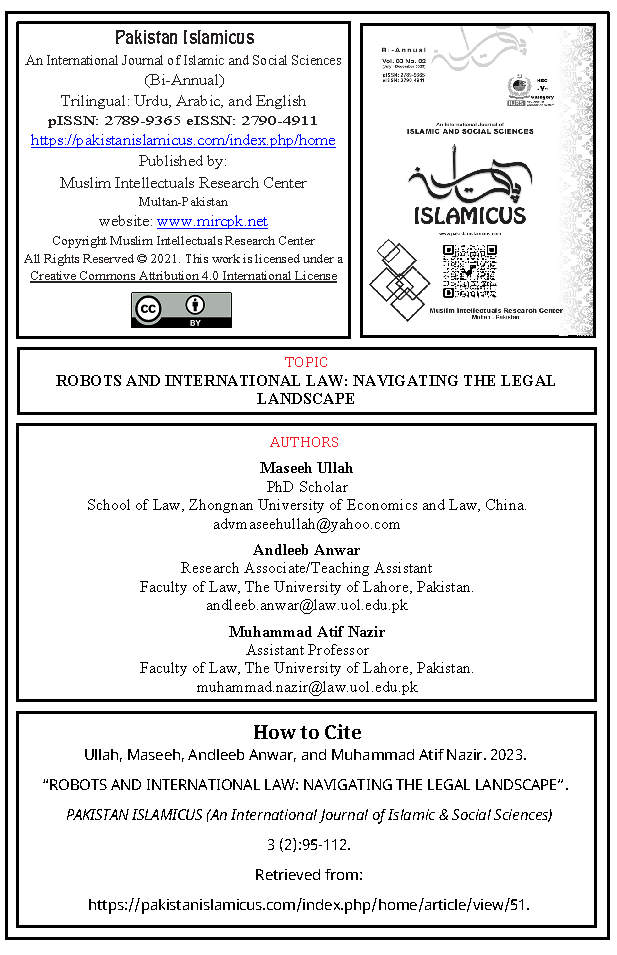ROBOTS AND INTERNATIONAL LAW: NAVIGATING THE LEGAL LANDSCAPE
Keywords:
Autonomous Systems, Compliance, Human Rights, International Law, RoboticsAbstract
Integrating robotics and artificial intelligence into military operations has raised complex legal questions regarding their compliance with international law. This paper delves into the multifaceted relationship between robots and international legal norms, exploring their implications in various domains. The study categorizes robotic weapon systems into three classifications based on human involvement: Human in Loop, Human On Loop, and Human Out of Loop systems. It scrutinizes the compliance of these systems with international laws, including International Human Rights Law, with a focus on humanity, the right to life, bodily integrity/security, due process rights, the right to remedy, and the extraterritorial application of human rights. Furthermore, the paper investigates the intersection of robots with International Humanitarian Law. It examines their impact on other international legal regimes, such as the Law of the Sea and Space Law. The analysis extends to the relevance of domestic legal frameworks in governing robotic technologies. By synthesizing these perspectives, this research contributes to a deeper understanding of the legal challenges posed by robots today. Ultimately, it highlights the need for a nuanced and comprehensive approach to ensure that robots comply with international law while serving various societal functions.
References
Arkin, R. (2018). Lethal autonomous systems and the plight of the non-combatant. The Political Economy of Robots: Prospects for Prosperity and Peace in the Automated 21st Century, 317-326.
Avliyoqulov, B. (2023). Navigating the Legal Landscape of Robots and AI in the Workplace: Challenges and Solutions. Uzbek Journal of Law and Digital Policy, 1(3).
Grut, C. (2013). The challenge of autonomous lethal robotics to international humanitarian law. Journal of Conflict and Security Law, 18(1), 5-23.
Hussain, N., Khan, A., & Memon, S. (2023). Addressing Marine Pollution: An Analysis of MARPOL 73/78 Regulations and Global Implementation Efforts. Journal of Social Sciences Review, 3(1), 572-589.
Hussain, N., Khan, A., & Wassan, R. (2023). UNCLOS 1982: Comparative Analysis of Marine Pollution Prevention by Ships. Annals of Human and Social Sciences, 4(2), 295-308.
Hussain, N., Khan, A., Chandio, L. A., & Oad, S. (2023). Individual Criminal Responsibility for the Crime of Aggression: The Role of the ICC's Leadership Clause. Pakistan Journal of Humanities and Social Sciences, 11(1), 223-232.
Khan, A. (2018). Autonomous Weapons and Their Compliance with International Humanitarian Law (LLM Thesis). Traditional Journal of Law.
Khan, A., & Hussain Shah Jillani, M. A. (2019). Killer Robots and Their Compliance with the Principles of Law of War. JL & Soc'y, 50, 55.
Khan, A., Iqbal, N., & Ahmad, I. (2022). Human Trafficking in Pakistan: A Qualitative Analysis. Journal of Social Sciences Review, 2(3), 257-268.
Khan, A., Khan, A. S., & Khan, I. (2022). Responsibility Of Killer Robots For Causing Civilian Harm: A Critique Of Ai Application In Warfare Doctrine. Pakistan Journal of International Affairs, 5(1).
Lemley, M. A., & Casey, B. (2019). Remedies for robots. The University of Chicago Law Review, 86(5), 1311-1396.
Milanovic, M. (2011). Extraterritorial application of human rights treaties: law, principles, and policy. Oxford University Press, USA.
Pagallo, U. (2016). The impact of domestic robots on privacy and data protection, and the troubles with legal regulation by design. Data protection on the move: Current developments in ICT and privacy/data protection, 387-410.
Robertson, J. (2014). Human rights vs. robot rights: Forecasts from Japan. Critical Asian Studies, 46(4), 571-598.
Sharkey, N. (2017). Why robots should not be delegated with the decision to kill. Connection Science, 29(2), 177-186.
Thomasen, K. (2020). Robots, Regulation, and the changing nature of public space. Ottawa Law Review, 51(2).
Thurnher, J. (2013). The Law That Applies to Autonomous Weapon Systems.
Wagner, G. (2019). Robot, inc.: personhood for autonomous systems?. Fordham L. Rev., 88, 591.

Downloads
Published
Issue
Section
License
Copyright (c) 2023 PAKISTAN ISLAMICUS (An International Journal of Islamic & Social Sciences)

This work is licensed under a Creative Commons Attribution 4.0 International License.
This work is licensed under a Creative Commons Attribution 4.0 International License.

































